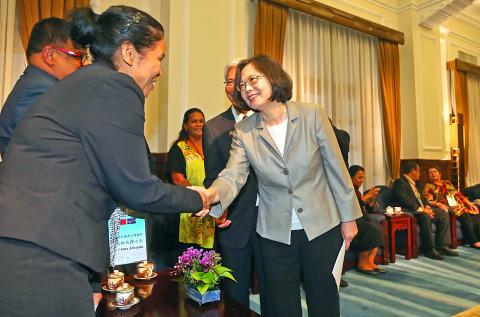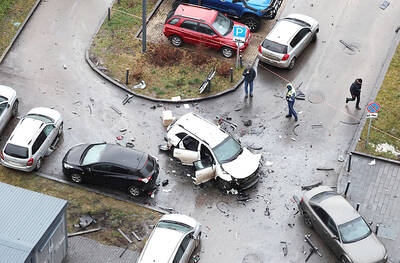President Tsai Ing-wen (蔡英文) yesterday met with Palauan President Tommy Remengesau Jr in her first open meeting after assuming the presidency on Friday, departing from the customary appellation used by former president Ma Ying-jeou (馬英九) by referring to her administration as the “Taiwanese government.”
Under Ma, public meetings with foreign dignitaries used the formal title of “Republic of China (ROC) government” when referring to Taiwan. While the word “Taiwan” was used sparingly, it was very rarely used in the context of the “Taiwanese government.”
Tsai welcomed Remengesau, who was in Taiwan for Tsai’s inauguration, and said that the two nations could cooperate on the issue of marine conservation.

Photo: CNA
When speaking on bilateral cooperation, Tsai used the term “we” and mentioned “the ROC.”
She said Taiwan can learn from important environmental achievements during Remengesau’s tenure, such as the Micronesian Center for a Sustainable Future and the Palau National Marine Sanctuary.
Meanwhile, Beijing yesterday warned Taiwan that it would cut off critical contacts if Tsai does not state her support for the “one China” framework.
The comments came a day after Tsai’s inauguration speech, in which she called for “positive dialogue” with China, but stopped short of any compromise on Beijing’s demands that she support its “one China” principle.
Beijing and Taipei have had regular, official communication since 2014, but that would stop unless Tsai acknowledges the so-called “1992 consensus,” Xinhua news agency quoted China’s Taiwan Affairs Office spokesman Ma Xiaoguang (馬曉光) as saying.
“The communication mechanism between the two departments can only continue if the 1992 consensus, which represents the common political foundation of the one China principle, is adhered to,” he was quoted as saying.
In her speech, Tsai reiterated her stance of recognizing that a meeting took place between the Chinese Nationalist Party (KMT) and Chinese officials in 1992, but did not endorse it.
The “1992 consensus,” a term former Mainland Affairs Council chairman Su Chi (蘇起) admitted making up in 2000, refers to a tacit understanding between the KMT and the Chinese government that both sides of the Strait acknowledge there is “one China,” with each side having its own interpretation of what “China” means.

TRAGEDY STRIKES TAIPEI: The suspect died after falling off a building after he threw smoke grenades into Taipei Main Station and went on a killing spree in Zhongshan A 27-year-old suspect allegedly threw smoke grenades in Taipei Main Station and then proceeded to Zhongshan MRT Station in a random killing spree that resulted in the death of the suspect and two other civilians, and seven injured, including one in critical condition, as of press time last night. The suspect, identified as a man surnamed Chang Wen (張文), allegedly began the attack at Taipei Main Station, the Taipei Fire Department said, adding that it received a report at 5:24pm that smoke grenades had been thrown in the station. One man in his 50s was rushed to hospital after a cardiac arrest

SAFETY FIRST: Double the number of police were deployed at the Taipei Marathon, while other cities released plans to bolster public event safety Authorities across Taiwan have stepped up security measures ahead of Christmas and New Year events, following a knife and smoke bomb attack in Taipei on Friday that left four people dead and 11 injured. In a bid to prevent potential copycat incidents, police deployments have been expanded for large gatherings, transport hubs, and other crowded public spaces, according to official statements from police and city authorities. Taipei Mayor Chiang Wan-an (蔣萬安) said the city has “comprehensively raised security readiness” in crowded areas, increased police deployments with armed officers, and intensified patrols during weekends and nighttime hours. For large-scale events, security checkpoints and explosives

PUBLIC SAFETY: The premier said that security would be tightened in transport hubs, while President Lai commended the public for their bravery The government is to deploy more police, including rapid response units, in crowded public areas to ensure a swift response to any threats, President William Lai (賴清德) said yesterday after a knife attack killed three people and injured 11 in Taipei the previous day. Lai made the remarks following a briefing by the National Police Agency on the progress of the investigation, saying that the attack underscored the importance of cooperation in public security between the central and local governments. The attack unfolded in the early evening on Friday around Taipei Main Station’s M7 exit and later near the Taipei MRT’s Zhongshan

A car bomb killed a senior Russian general in southern Moscow yesterday morning, the latest high-profile army figure to be blown up in a blast that came just hours after Russian and Ukrainian delegates held separate talks in Miami on a plan to end the war. Kyiv has not commented on the incident, but Russian investigators said they were probing whether the blast was “linked” to “Ukrainian special forces.” The attack was similar to other assassinations of generals and pro-war figures that have either been claimed, or are widely believed to have been orchestrated, by Ukraine. Russian Lieutenant General Fanil Sarvarov, 56, head